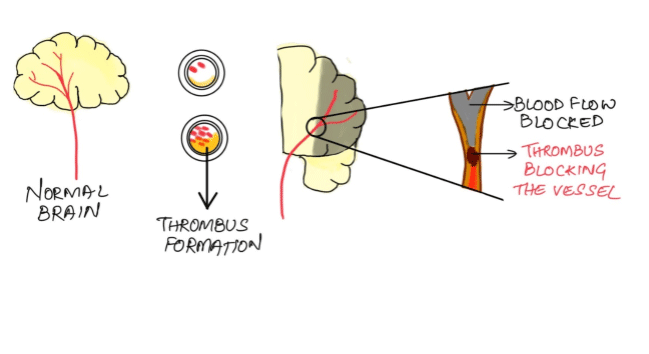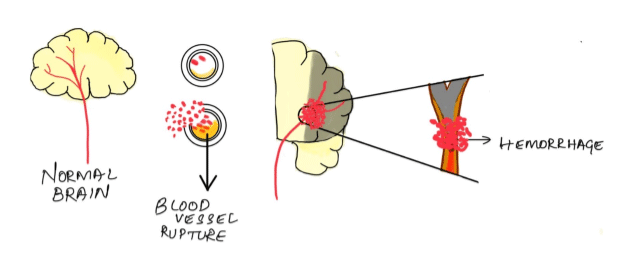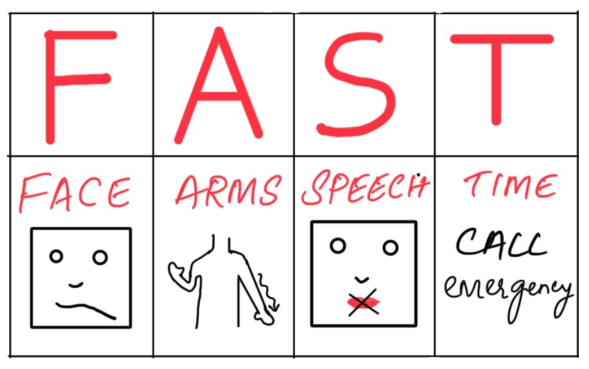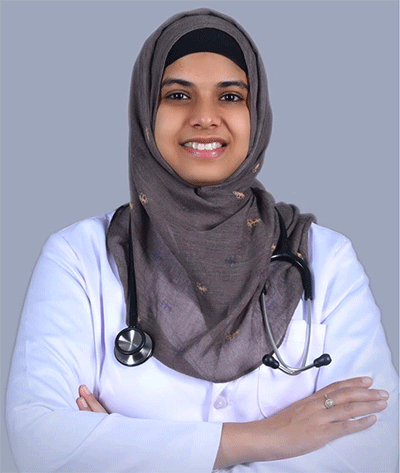An elderly man with difficulty in walking, a young woman with inability to speak, a child with vision loss. These are few of the different scenarios we come across in people with stroke. It is heart wrenching to see young and old people alike having to face these disabilities. This world stroke day, let us increase our understanding of stroke.
As rightly said by the Dutch philosopher Desiderius Erasmus ‘Prevention is better than cure', Stroke is an event which can be prevented by simple measures but may leave one disabled for life if neglected. In India, around 1.8 million people suffer from a stroke every year and many survivors face disability. Having one stroke increases the risk of another or recurrent stroke. Since 80% of the strokes are preventable, it becomes all the more important for us to have a thorough knowledge about this disease and its prevention.
What is stroke?
Stroke happens when blood flow to a part of your brain is impaired. Due to the lack of oxygen rich blood, that part of the brain tissue undergoes cell death, leading to brain damage, disability and death.
Stroke can happen in one of the two ways:
1. Ischaemic stroke- It occurs when blood supply to the brain is blocked, which can be due to an embolism stroke or a thrombotic stroke.
Embolic stroke: In embolic stroke, blood clots forms somewhere in the body (usually the heart) and travels through the bloodstream, into the brain, blocking the blood vessel, causing stroke.
Thrmobotic stroke: In this type of ischaemic stroke, the blood flow is impaired due to a blockage in one or more of the arteries that supply blood to the brain. This process is known as thrombosis.

2. Hemorrhagic stroke- This occurs when a blood vessel in the brain bursts. Hemorrhage can be caused by a number of disorders that affect the blood vessels, including high blood pressure and cerebral aneurysms.

What are the risk factors?
High blood pressure
►High cholesterol
►Atherosclerosis
►Smoking
►Physical inactivity
►Diabetes
►Atrial fibrillation
►Obesity
Traditionally, increased age has been found to be a risk factors for stroke. However, due to the change in life style in the current generation, increasing incidence of stroke in young have been reported. Risk factors may not be identified and treated in middle aged adults and hence it is important to screen for high BP and high cholesterol in middle aged adults.
What are the symptoms and signs of stroke?
An easy way to remember the most common sign of stroke and how to respond is with the acronym FAST

F- Face drooping: ask the person to smile
Does one side droop?
A- Arm weakness: ask the person to raise both arms. Does one arm drift downward?
S- Speech difficulty: ask the person to repeat a simple sentence. Are the words slurred?
T- Time to call emergency service: IF the person shows any of these signs, call emergency service immediately.
Other signs and symptoms include:
Sudden giddiness, loss of balance, difficulty in walking
Sudden loss of vision in one or both eyes
Sudden severe headache with no known cause
Sudden numbness or weakness of face, arm or leg – especially on one side of the body
Sudden confusion or difficulty in understanding others.
How is stroke diagnosed?
Stroke is diagnosed initially based on the patients’ symptoms and clinical examination. Initial evaluation is done to assess the level of consciousness and function, to determine the cause, location and severity of stroke. Further confirmation is obtained by imaging studies, namely Computerised Tomography (CT scan) and Magnetic Resonance Imaging (MRI brain). Other tests that may be required include ECG, 2D ECHO and Neck vessel Doppler.
Treatment:
In stroke, “Time is brain.” A stroke can cause permanent damage within minutes to hours. Its treatment and outcome depends on how fast you get to the hospital. Early treatment can minimize the extent of brain damage, thus reducing the morbidity associated with this condition. Treatment also depends on the type of stroke, whether ischemic or hemorrhagic.
Treatment following a stroke generally falls into three therapeutic approaches:
►Emergency medical or surgical care given immediately after a stroke to minimize the extent of injury
►Treatment to prevent a second or recurrent stroke
►Rehabilitation to improve disabilities that result from stroke
Ischemic stroke treatment:
Medications:
Medication or drug therapy is the most common treatment for ischemic stroke. These include:
1. Thrombolytics: These are drugs that break up and dissolve existing clots. The thrombolytic drug-Tissue Plasminogen Activator (t-PA) can be effective if a person receives it intravenously (through a vein) within 4.5 hours from the onset of stroke symptoms. This highlights the importance of seeking early medical assistance for any individual with symptoms of stroke, so that timely intervention can be provided.
2. Antithrombotics: Antithrombotics prevent the formation of blood clots in a brain artery. There are two kinds of blood-thinning medications—antiplatelets and anticoagulants
► Antiplatelet drugs prevent clotting by decreasing the activity of platelets, which are blood cells that cause blood to clot. By reducing the risk of blood clots, these drugs lower the risk of ischemic stroke. The most widely known and used antiplatelet drug is aspirin. Other antiplatelet drugs include clopidogrel, ticlopidine, and dipyridamole.
► Anticoagulants lower the risk of stroke by reducing the clotting property of the blood. The most commonly used anticoagulants include warfarin, heparin, enoxaparin, and dalteparin. The newer anticoagulants include dabigatran, apixaban, edoxaban, and rivaroxaban.
Endovascular procedures- Mechanical Thrombectomy:
► These have been the new revolutionary treatment options in the management of stroke. Clot removal involves threading a catheter through the artery to the site of the blockage and removal of clot through suction, or other devices.
Surgical procedures:
►The carotid arteries, located in the neck, are the main suppliers of blood to the brain.
►Carotid endarterectomy involves surgical removal of obstructing plaque from the inside of a carotid artery which widens the artery.
Hemorrhagic stroke:
Treatment for hemorrhagic stroke involves finding the source of the blood leak and controlling it. It requires supportive care in the form of controlling the blood pressure and other symptomatic treatment. In severe cases, surgery may be required to relieve the intracranial pressure caused by the bleeding.
Rehabilitation:
► Rehabilitation is vital to stroke recovery.
► Physical, occupational and speech therapy is the main form of rehabilitation for most people with stroke. These therapies use training and exercises to restore movement, balance, speech and skilled activities.
► Psychological or psychiatric help can assist many people suffering from depression, anxiety and frustration, which are common disabilities in people with stroke. Therapy, along with medication, can help ease some of the mental and emotional problems that result from stroke.
Prevention of stroke
There are several steps you can take to reduce stroke risk:
► Eat healthy: Choose healthy foods including foods with less salt, with plenty of fruits and vegetables.
► Physical Activity: Regular physical activity helps to maintain a healthy weight and keeps your heart and blood vessels healthier. Adults aged 18 years or older should get at least 150 minutes (2 hours and 30 minutes) of physical activity each week.
► Avoid smoking
► Avoid alcohol
► Screen for lifestyle disorders such as high BP, high cholesterol, diabetes and obesity. Follow up regularly if diagnosed with any of these diseases.

Dr. Salma Suhana
Assistant professor, Department of Neurology
Yenepoya Medical College and Hospital
Deralakatte, Mangalore.
Consultant Neurologist
Medi Nerv, Mangalore.
Let the Truth be known. If you read VB and like VB, please be a VB Supporter and Help us deliver the Truth to one and all.
New Delhi (PTI): A Private Member's Bill seeking a clear legal framework for regulation of deepfakes has been introduced in the Lok Sabha.
The Regulation of Deepfake Bill, introduced by Shiv Sena leader Shrikant Shinde in the House on Friday, aims to protect citizens by mandating prior consent from individuals depicted in deepfake content.
"Misuse of deepfakes for harassment, deception and misinformation has escalated, creating an urgent need for regulatory safeguards," Shinde said.
The Bill also lists penalties for offenders creating or disseminating deepfake content with malicious intent.
"With advancements in artificial intelligence and deep learning, deepfake technology has emerged as a significant tool for media manipulation. While the technology has potential applications in education, entertainment and creative fields, it also poses severe risks when misused, threatening individual privacy, national security and public trust," Shinde said in the statement of objects and reasons in the Bill.
The proposed Bill seeks to establish a clear legal framework to govern the creation, distribution and application of deepfakes in India, said Shinde, a three-term Lok Sabha member from Kalyan.
The Bill also seeks to establish the Deepfake Task Force, a dedicated body to combat national security implications and evaluate the influence of deepfakes on privacy, civic participation, and potential election interference.
The task force will collaborate with academic and private sector institutions to develop technologies that detect manipulated content, thereby promoting credibility in digital media.
The Bill also proposes to establish a fund to support public and private sector initiatives in the detection and deterrence of advanced image manipulation.
A Private Member's Bill is a procedure of Parliament that enables lawmakers, who are not ministers, to draw attention to issues that might not be represented in Government Bills or to highlight the issues and gaps in the existing legal framework that require legislative intervention.





